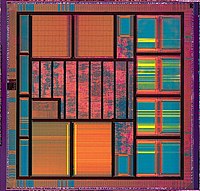
Photo from wikipedia
The addition of toxic substances and poor durability severely limit the market applications of superhydrophobic coatings in the oil–water-separation industry, anti-icing, and self-cleaning surfaces. In order to solve the above… Click to show full abstract
The addition of toxic substances and poor durability severely limit the market applications of superhydrophobic coatings in the oil–water-separation industry, anti-icing, and self-cleaning surfaces. In order to solve the above problems, a stable, strong, fluorine-free superhydrophobic coating was prepared according to natural inspiration. In this study, polydivinylbenzene (PDVB) was produced by the hydrothermal method, and micro-nanoparticle clusters composed of PDVB particles of different sizes were prepared by controlling the ratio of raw materials, which was then attached to the substrate surface by a simple spraying technique. A rough coating with a lotus-leaf-like layered protruding structure was constructed by depositing particle clusters of different sizes. In the end, the prepared coating showed attractive superhydrophobicity, with a maximum contact angle (CA) that reached up to 160°. In addition, the coating had long-lasting superhydrophobic properties in various environments, such as common liquid and acidic and alkaline solutions. Moreover, in the oil–water-separation process, the superhydrophobic filter paper was still able to obtain a separation efficiency of more than 85% after being used 50 times, and it maintained a contact angle of >150°. At the same time, the coating had excellent dye resistance and self-cleaning performance.
Journal Title: Materials
Year Published: 2022
Link to full text (if available)
Share on Social Media: Sign Up to like & get
recommendations!